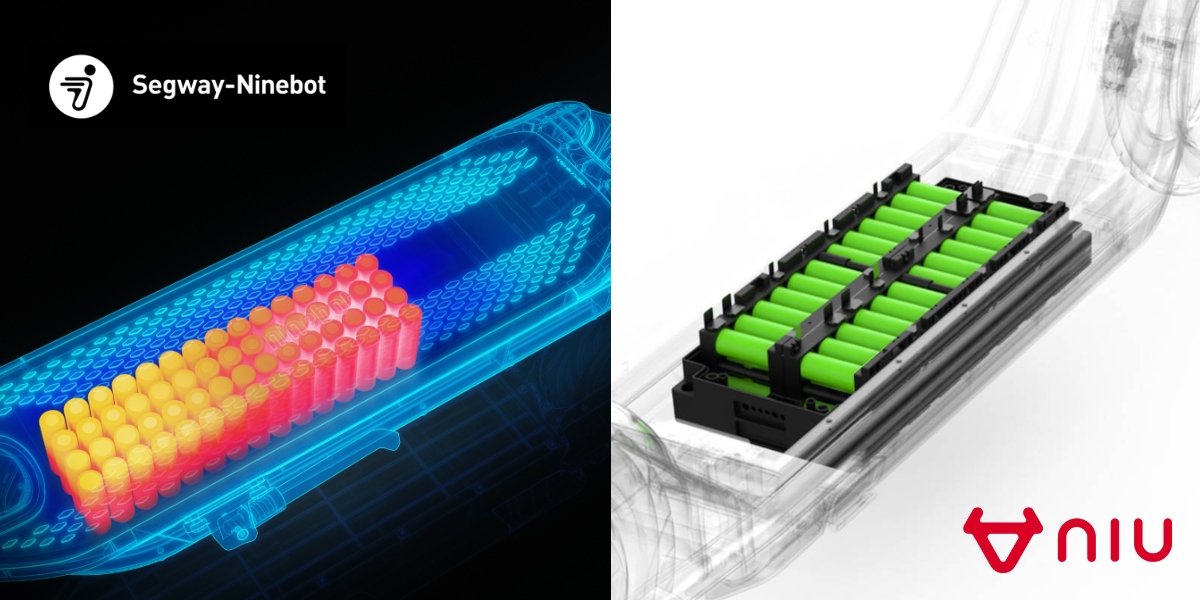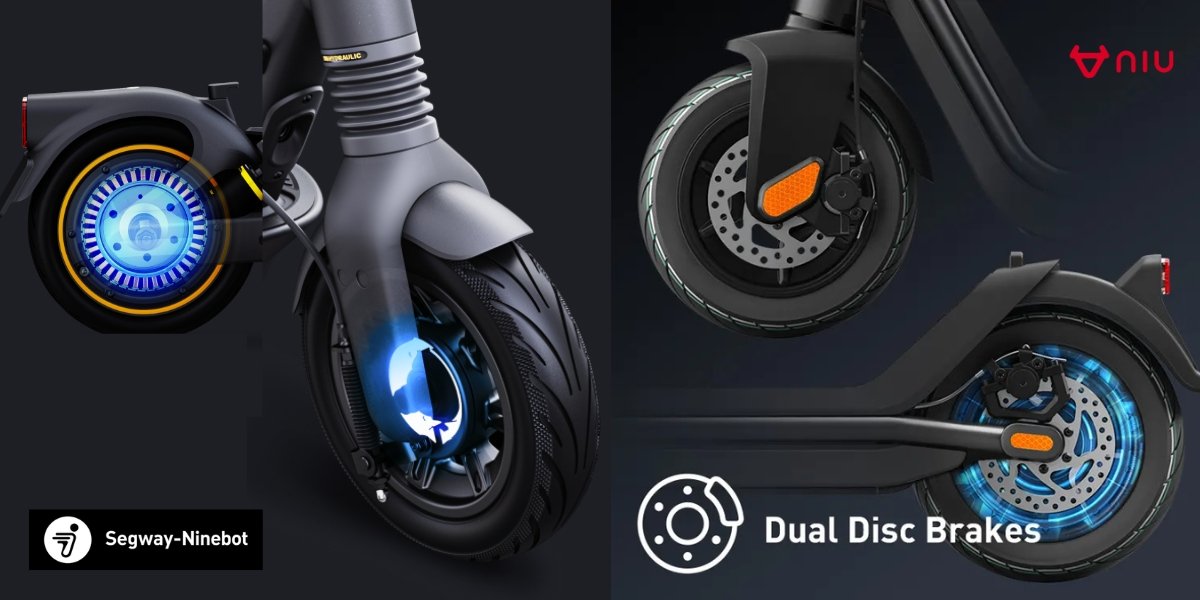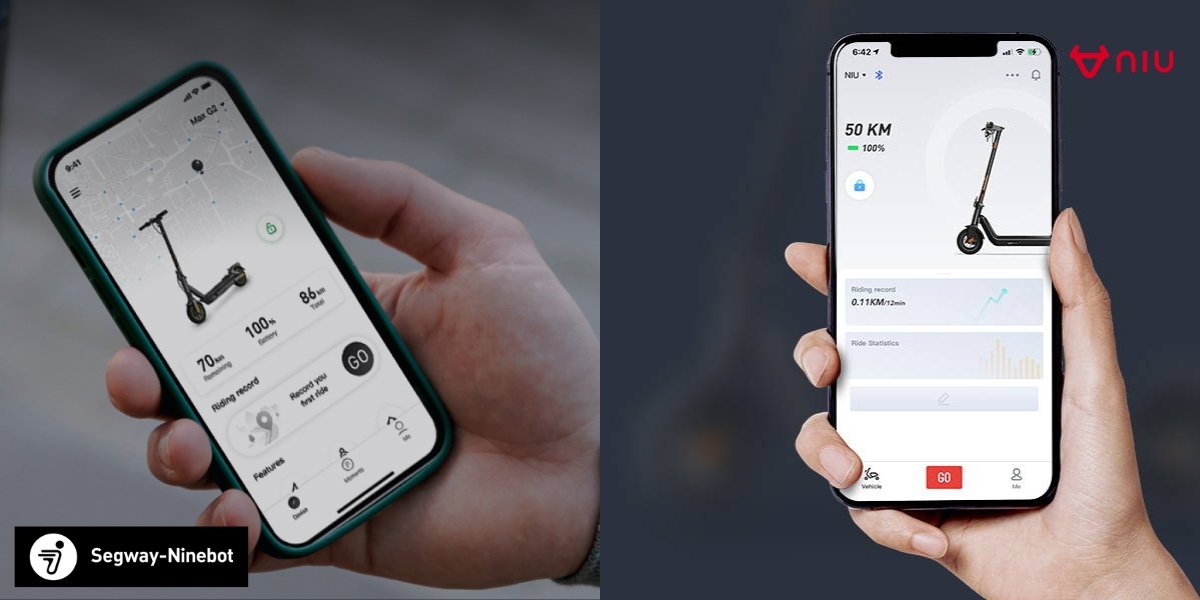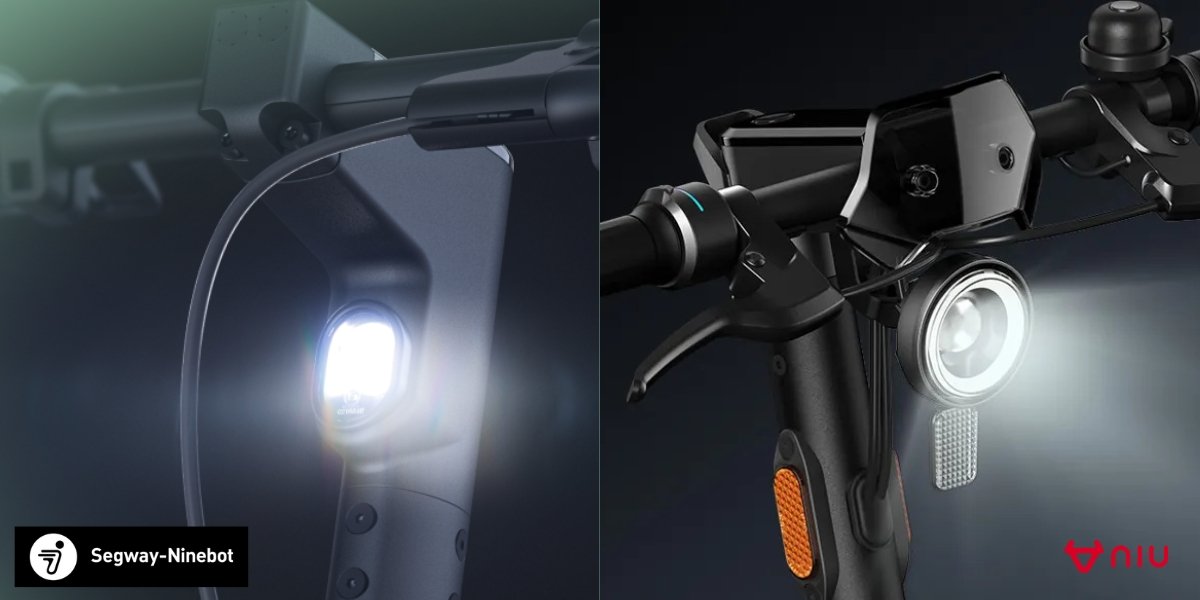Micromobility is here to stay, and it’s changing how we experience urban life for the better. With Unagi’s membership program, you can enjoy all the benefits of a top-tier electric scooter without the sky-high price of ownership or the inconvenience of ride-sharing.
To the untrained eye, the Segway Ninebot Max G2 and the NIU KQi3 Pro look fairly similar. They are both relatively large, robust electric scooters with chunky wheels that offer a comfortable ride. However, there are a few key differences that give each its own distinct personality and unique capabilities.
Segway, best known for its two-wheeled self-balancing transporters, has been around since 1999 and has garnered a well-respected name for itself in the industry. Established in 2014, NIU is more of the new kid in the industry but has been praised for its innovative designs and affordability.
If you're in the market for a quality electric scooter, both the Segway Ninebot Max G2 and the NIU KQi3 Pro would make excellent options and you'd probably be happy with either one. But when you knuckle down and compare the two, which one comes out on top?
In this article, we set these scooters side by side and examine everything from their cost to their hill-climbing ability and everything in between. Let's find out which of these scooters offers the best of the best overall!
NIU KQi3 Pro vs Segway Ninebot Max G2 Comparison Table
The table below compares the key features of both the NIU KQi3 Pro and Segway Ninebot Max G2:
| Scooter Specs | Segway Ninebot Max | NIU KQi3 Pro |
|---|---|---|
| Cost | $799-$1399 | $499-$799 |
| Motor | 450 W | 350 W |
| Battery | 551 Wh | 486 Wh |
| Top Speed | 22 mph | 20 mph |
| Range | 43 miles | 31 miles |
| Brakes | Regenerative braking system | Regenerative braking system |
| Scooter Weight | 53.57 lbs | 44.8 lbs |
| Max Rider Weight | 265 lbs | 265 lbs |
| Construction Materials | High-strength steel | Aluminum |
| Tires | Self-healing tires | Pneumatic tires |
| Lights | Front and rear lights | Front and rear lights |
| Battery Charge Time | 6 hours | 6 hours |
| Weather Resistance | IPX5 | IP54 |
| Climbing Angle | 22 degrees | 20 degrees |
| Suspension | Dual suspension system | None |
Cost
If you are paying full price for your electric scooter, you can expect to pay around $799 for the NIU KQi3 Pro and roughly $1399 for the Segway Ninebot Max G2. However, you can find the NIU KQi3 Pro for around $499 and the Segway Ninebot Max for $799 when these scooters are on sale.
Either way, you can expect to pay around double for Segway's contender than you would for NIU's. But is this extra expense really worth it? We'll leave that up to you to decide once you have learned more about the features offered by both of these highly-rated electric scooters.
It's safe to say that if you don't have a significant amount of disposable income, you may find yourself leaning toward the more affordable option... especially if you're looking to purchase a scooter as soon as possible.
Remember to always purchase your electric scooters directly from the manufacturer if you want to enjoy the intended warranties. Being in direct contact with the manufacturers is also useful should you encounter any issues.
Performance
Neither of our two competitors has dual motors or impressive torque, but they both offer fairly decent performance capabilities, although the Segway Ninebot Max G2 does come out on top in most performance comparisons.
One of the major differences between the NIU KQi3 Pro and the Segway Ninebot Max G2 is the motor power, which directly impacts the scooters' overall performance.
The NIU KQi3 Pro boasts a humble 350 W of motor power, while the Segway has a 450 W rear motor with a 1,000 W peak. But does this 450 W translate accordingly? Let's find out.
Speed and Acceleration
The NIU KQi3 Pro’s top speed is roughly 20 miles an hour, while the Segway Ninebot Max G2's top speed is 22 miles per hour. When you consider the Segway's impressive motor power, you would probably expect the top speed to be slightly higher.
However, you should keep in mind that US traffic regulations ensure that scooters are only allowed to travel at a maximum speed of 20 miles an hour. Therefore, you'd only be able to enjoy the Segway Ninebot Max G2's higher speeds when you're riding on private property.
The larger motor definitely helps when it comes to acceleration. The Segway Ninebot Max G2 allows you to reach your desired speed within seconds thanks to its increased power. Another of the G2's major advantages is its innovative RideyLONG technology, which is to thank for the scooter's powerful rear-wheel drive and extended range.
Range and Battery
If you're looking to travel long distances, the Segway Ninebot Max G2 definitely comes out on top with an impressive range of roughly 43 miles (depending on your speed). This makes it the ideal electric scooter for commuting.
So, how does the NIU KQi3 Pro fair in comparison? Not too badly, actually. The Pro's range sits at around 31 miles, which is still more than enough for the average rider as most people don't cover more than this distance in a single day.
When it comes to battery size, there isn't a huge difference to comment on. Both scooters make use of lithium-ion batteries with a wide variety of built-in battery protection systems to ensure your scooter battery stands the test of time. Both batteries take roughly six hours to charge, which is an ideal time for overnight charging.
The only significant difference between the batteries is that the NIU KQi3 Pro takes a 486 Wh (watt-hour) battery while the Segway Ninebot Max G2 has a 551 Wh battery. Be sure to read the care instructions from the relevant manufacturers to ensure you look after your battery properly.
Batteries play a significant role in the longevity and performance of electric scooters. After all, they spend a significant amount of time being charged and drawing on the battery for power. Fortunately, both of these scooters have reliable batteries that are sure to stand the test of time.

Hill Climbing
A larger climbing angle means your scooter can handle steeper slopes while transporting you throughout the city. The NIU KQi3 Pro offers a climbing angle of 20 degrees, while the Segway Ninebot Max G2 has a slightly wider climbing angle of 22 degrees.
With its impressive rear-drive motor, you would expect the G2 to have a better hill-climbing ability, although 22 degrees is still more than sufficient for most urban landscapes. The climbing angle will only be a significant deciding factor if you live in a very hilly area, such as San Francisco.
Braking
Without the right brakes, you could risk injuring yourself or others when riding your electric scooter around town. Fortunately, both scooters in this comparison offer impressive braking capabilities... as they should!
The NIU KQi3 Pro scooter has a triple brake system, comprising front and back disc brakes, as well as a back electronic brake. The system is made from die-cast aluminum alloy, which is both lightweight and highly durable.
The Segway Ninebot Max G2's braking system is just as impressive, boasting a front drum brake for quick deceleration and an electronic rear brake that assists with the rear-wheel drive system.
You may have noticed that both scooters have regenerative electronic back brakes. This means that using your back brakes actually helps charge up the batteries instead of drawing from them.

Build Quality
Based on the materials used, customer reviews, and the overall design of the NIU KQi3 Pro and Segway Ninebot Max G2, it's clear that both of these scooters have an impressive build. Both Segway and NIU are known for their reliable products, so you really can't go wrong with either option.
Let's have a look at some of the aspects that impact build quality, including aesthetics, materials, and durability.
Aesthetics
These days, aesthetics play a huge role in an electric scooter's overall look and feel. Both models actually have a similar design in that they are robust with chunky wheels and wide decks. NIU's KQi3 series is often referred to as the 'SUV of scooters' and the same could be said for the Segway Ninebot Max G2.
As far as colors go, the NIU KQi3 Pro comes in black and rose gold, while the Segway Ninebot Max G2 comes in black with pops of yellow on the rims. All of these colorways look stylish and modern and are sure to remain 'in style' for many years.
Aesthetically, the main difference between the two models is the Niu KQi3 Pro's round Halo light, which acts somewhat as its focal point. In contrast, the Segway Ninebot Max G2's lights are a lot more subtle.
Materials and Durability
The prominent material used in most NIU scooters is aluminum, which ensures the scooters are lightweight yet durable. With rubber tires and lithium-ion batteries, the NIU KQi3 Pro boasts an impressive range of materials with an approximated lifespan of 10 years or more.
On the other hand, Segway scooters (including the Ninebot Max G2) are typically made from high-strength steel. While steel can add to the scooter's overall weight, it is known for being highly durable and water resistant.
If you had to split hairs, the G2 is probably the more durable of the two models in this comparison. But the NIU KQi3 Pro would still serve you well and give you many years of safe and enjoyable riding experiences.
Ride Quality
With fat tires, wide decks, and wide handlebars, both the NIU KQi3 Pro and the Segway Ninebot Mad G2 are praised for their comfortable riding experiences, allowing riders to explore city streets with confidence!
So, which model has the better ride quality? This may depend on your preferred riding style, but we'll still break down the main contributing factors so that you can make an informed decision.
Tires
With 30% fatter wheels than the average range, you can look forward to a comfy ride when cruising around on the NIU KQi3 Pro. The large pneumatic tires measure an impressive 9.5", allowing excellent shock absorption.
Thought it couldn't get much better than that? Well, think again because Segway's offering definitely beats NIU's when it comes to tires. The Segway Ninebot Max G2's tires measure a whopping 10'' and are self-healing, which means that punctures are repaired as they happen.
These self-healing tires mean that you'll never have to stop to try and repair a puncture, wasting precious time on your commute. The innovative self-healing technology takes care of everything for you!
Suspension
Suspension improves the rider's comfort when traveling over bumpy surfaces like uneven concrete or potholes. However, most electric scooters, including the NIU KQi3 Pro, don't offer suspension.
If you are looking for a scooter with a suspension system, the Segway Ninebot Max G2 may be an excellent choice. With its double suspension system, you can easily ride over speed bumps and along gravel roads - the exploration opportunities are endless.
The addition of suspension is most likely why the G2 sits at a significantly higher price than the KQi3 Pro. So, it's up to you to determine whether you deem suspension as a necessary feature for your electric scooter.
Deck Space
The size of the deck is a clear indication as to whether the scooter was built for kids, teens, or adults. As an adult, you want to go for a larger deck space if you want to ride around in comfort. Fortunately, both models in this comparison offer impressive deck sizes:
- NIU KQi3 Pro: 22"L x 6.7" W
- Segway Ninebot Max G2: 20.5"L x 6.7"W
While these scooters offer identical widths, the NIU KQi3 Pro deck is actually 2 inches longer, which is great for those who have longer legs or prefer a slightly wider stance while riding their electric scooter. Both decks offer a rubberized grip to provide you with a stable ride.
Portability
When deciding on which scooter to go for, a major consideration is always portability. After all, you may need to take your scooter on the bus and carry it up stairwells. You'll also need to store it somewhere in your home and you don't want to deal with anything that's too heavy and cumbersome.
While both the NIU KQi3 Pro and the Segway Ninebot Max G2 are quite large in size, they are easily portable thanks to their folding design. NIU's innovative folding system, which has actually been patented, allows you to fold up the scooter with just one quick motion.
One of the downsides of the Segway Ninebot G2 is that it's quite heavy compared to the NIU Kwi3 Pro—just under 10 lbs heavier, to be exact. This is mostly because of its sturdy steel design. However, if you are happy to carry the 50 lb scooter when you need to, you'll still enjoy a highly portable and top-quality scooter.
Weather Resistance
As a scooter rider, you should always be aware of various weather conditions and whether your particular mode can handle them. The NIU KQi3 Pro has a weather resistance rating of IP54, which means the scooter is resistant to dust and splashes. You can ride it in light rain and through shallow puddles, but you shouldn't push it much further than that.
In contrast, the Segway Ninebot Max G2 can be ridden in almost any condition thanks to its impressive IPX5 weather-resistant rating for the body and its IPX7 weather-resistant rating for the battery. The G2's traction control system and self-healing tires also make it an ideal choice for riding on rainy days.
The traction control helps you break on slippery surfaces and keeps the rider safe, even in wet conditions, so this is a huge advantage for the Segway Ninebot Max G2.
Apps
In this modern day and age, there is an app for just about everything, including electric scooters. The NIU KQi3 Pro comes with its very own dedicated app which allows you to track your rides, customize your speed, and enjoy a cruise-control setting.
Segway's electric scooters also come with a mobile app, which lets you adjust certain settings, check the battery health, and customize settings, among many other features. Both scooters also offer Bluetooth connectivity for your convenience.
These mobile applications make it so much easier to learn more about your electric scooter and connect other apps like maps and music.

Safety
Unfortunately, your brand-new electric scooters may catch the eye of opportunistic thieves. But there is no need to worry, as these scooters allow you to lock them remotely, giving you peace of mind. The NIU KQi3 Pro allows you to lock the scooter through the app, and the Segway Ninebot Max G2 has a built-in alarm system.
'Apple Find My' allows you to track your Segway Ninebot Max G2 at all times, ensuring that it will never go missing... even if you forget where you parked it! This feature is only compatible with Apple devices.
Always remember to lock your scooter if you're leaving it out of sight and to try to park it in dedicated scooter/bicycle parking spaces.
Lights
Both the NIU KQi3 Pro and the Segway Ninebot Max G2 come with front and rear lights to guide your way and ensure your visibility on the road. Lights play an essential role in your safety as a scooter rider.
The NIU KQi3 Pro's Halo light is one of its most prominent features, with the 'halo' part of the light staying on during the day for increased daytime visibility. At night or on darker days, you can switch on the center part of the light too. On the downside, this model doesn't have indicators.
What about the Segway Ninebot Max G2? It offers a 2.1 W high-power LED front light. It also has a rear light as well as front and rear indicators so that other people on the road can determine your intended direction.

Ideal Riders
Both the NIU KQi3 Pro and the Segway Ninebot Max G2 should attract a similar type of rider. Both have a maximum weight limit of 264.5 lbs and a recommended riding age of at least 14 years old. However, you should always check with local authorities about the legal requirements and minimum ages regarding electric scooters in your areas.
Although both models are great for teens, they are also ideal for most adults, thanks to the wide deck and the overall robustness of the designs. The main difference is undoubtedly the suspension, which lends the Segway Ninebot Max G2 to be better suited for those riding on rougher terrains.
Someone who wants to use a scooter on a daily basis for commuting over bumpy surfaces and in wet conditions would be happier with the Segway Ninebot Max G2 than they would with the NIU KQi3 Pro.
Verdict
When it comes down to it, the Segway Ninebot Max G2 clearly comes out on top in terms of speed, performance, range, suspension, lights, and many other factors. The additional cost is in direct correlation with this electric scooter's superiority.
However, if you are looking for a starter scooter that isn't as expensive and is slightly more portable, then the NIU KQi3 Pro is an excellent choice! You'll save at least a few hundred dollars and still enjoy many of the same features. It all depends on your lifestyle and specific needs.
Battling to decide between the two? You may want to look into the NIU KQi3 Max, which is the upgrade of the NIU KQi3 Pro. Not only does the NIU KQi3 Max have a larger motor, but it also offers a wider climbing angle and is still significantly cheaper than the Segway Ninebot Max G2.
If you're still not ready to buy, you could always look at renting a scooter to help you determine your likes and dislikes and whether or not they are the right choice for you.

Stay current with the latest U.S. electric scooter laws in our 2025 guide. Updated annually since our first comprehensive guide, ensuring you have the most recent state and city regulations to ride responsibly”

The Slack Core 920R is currently the fastest electric scooter in 2025 that you can purchase without the need for pre-order.

Our selection of the best electric scooters 2025 spans the fastest e-scooters to the most portable ones, the ones designed for city riding and off-road, the best scooters for rain, budget electric scooters for students, and more powerful ones for skilled riders.

The Unagi Voyager is the best lightweight electric scooter for adults and teenagers. It is the ultraportable sequel to its predecessor, the Unagi Model One Classic.

If you're wondering whether an electric scooter with a seat is right for you, this is a detailed article that would suit your need.

Understand which personal electric vehicle is best, the choice between an electric bike or electric scooter might already be made for you by some critical factors, including portability and storage capacity.

In the U.S., most states don't require a license. For those that do, they usually just ask for a regular driver's license or a learner's permit.

Yes, you can bring an electric scooter on a plane, but it needs to have a lithium battery smaller than 100 watt-hours, which most don't.

Manufacturers advise against riding electric scooters in the rain. The main reasons are: water can fry the electronics, make the ride dangerous, and void your warranty.

The basis and the premise of my work is that we either operate out of love or we operate out of fear...Time is currency. The coolest thing about the scooters is that it's really quick, and it goes uphill. From there, traveling more efficiently and having a good time doing it--I think that's the most important thing.

Cynthia Leu has a full plate. A tech worker by day, Cynthia spends her off time balancing the parallel lives of a powerlifter, entrepreneur, mental health advocate, and more. Riding Unagi helps this USMC veteran cut down on everyday…

https://www.youtube.com/watch?v=7m2hVBE62LY Rasheed Muhammad is sick of Los Angeles traffic. In order to preserve his sanity, Rasheed has traded his everyday driving habit for the portable and beautiful Unagi Model One. It’s an essential accessory for navigating LA streets -- and…

Rich Lee, Co-Founder of San Francisco’s SPRO Coffee Lab, wants to share his love for coffee with the world. He depends on riding Unagi to avoid the hassle of navigating the parking crunch in the booming Mission Bay neighborhood.…












